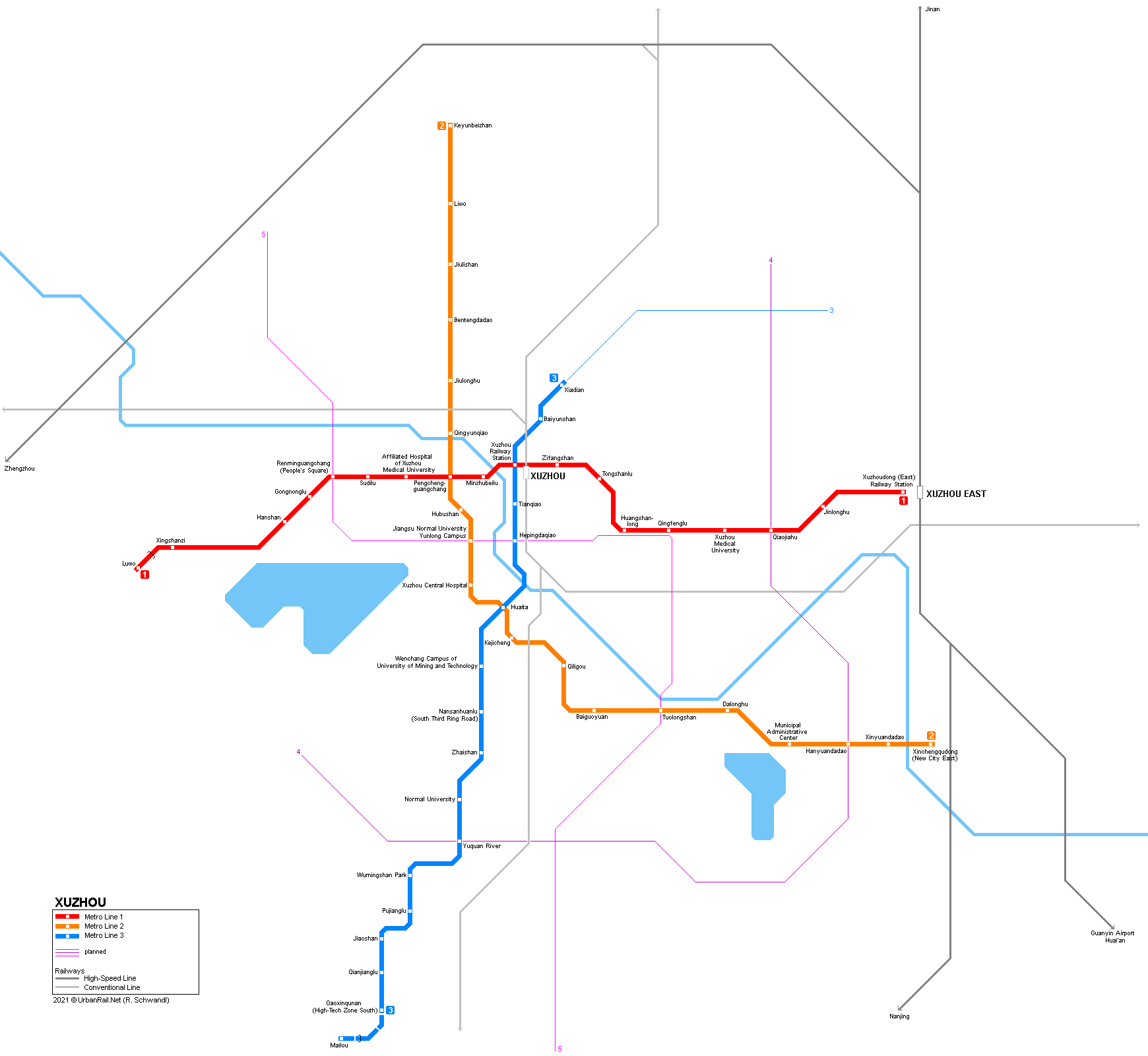
|
[ UrbanRail.Net ] [ Europe ] [ Americas ] [ Asia ] [ Africa ] [ Oceania ] [ News ] [ Books ] [ Links ] [ Blog ] [ Shop ] |
|
XUZHOU
|
| Jiangsu - China |

|
METRO
|
|
Xuzhou, 3 million inhabitants, in the north of Jiangsu province, some 290 km north of Nanjing and 650 km south of Beijing.
|
| Line 1 |
|
22 km, 18 stations, east-west line, 28 Sept 2019: Luwo – Xuzhoudong Railway Station (22 km)
|
|
|
| Line 2 |
|
24.2 km, 20 stations, north-south line 28 Nov 2020: Keyunbeizhan (North Coach Station) – Xinchengqudong (New City East)
|
|
|
| Line 3 |
|
26.3 km, 22 stations, north-south line 28 June
2021: Xiadian – Gaoxinqunan (High-Tech Zone South) (18.1 km)
|
|
|
| Line 6 |
|
28 Sept 2025: Xuzhou Tongshan District Hospital of TCM – Xuzhoudong Railway Station (22.9 km)
|
|
Links
|
|
Xuzhou Metro (Official Site) Xuzhou Metro at Wikipedia
|
|
Photos
|
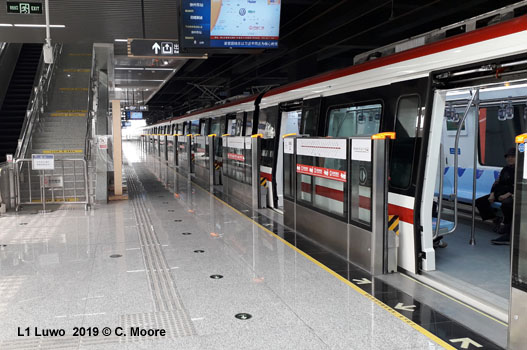
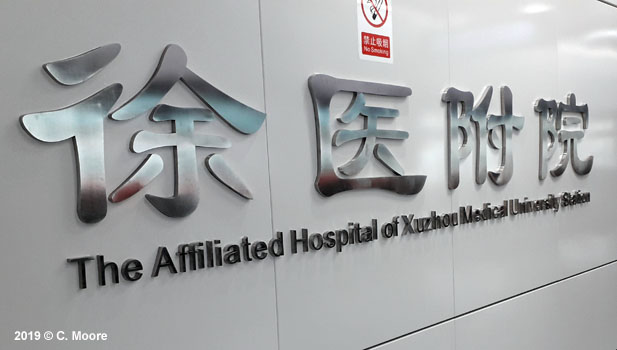
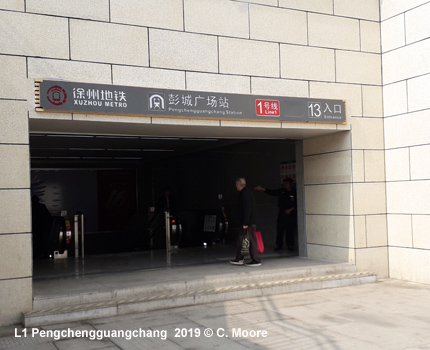
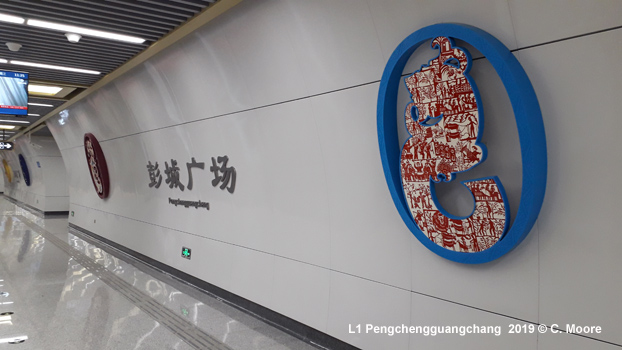
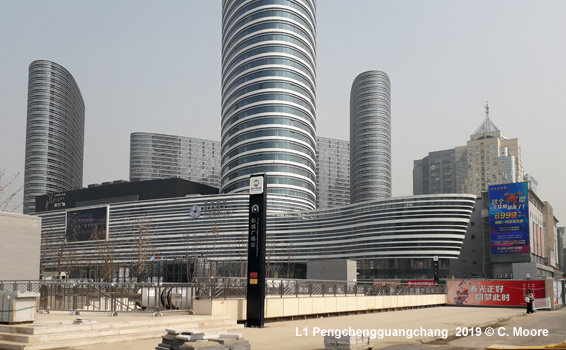
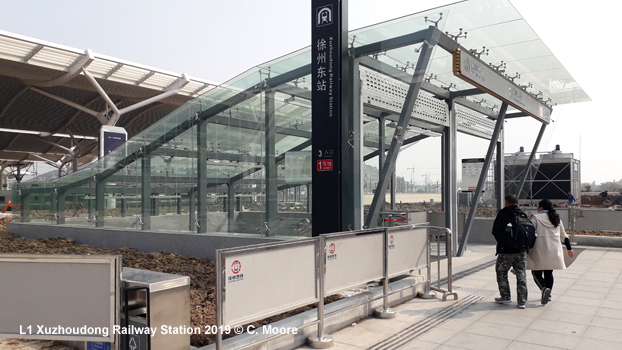
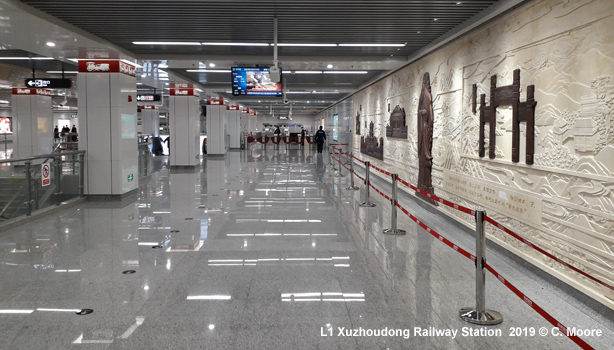
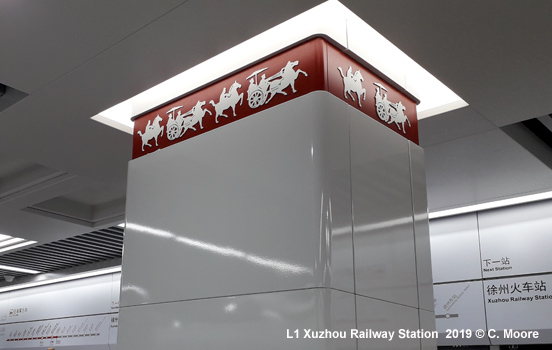
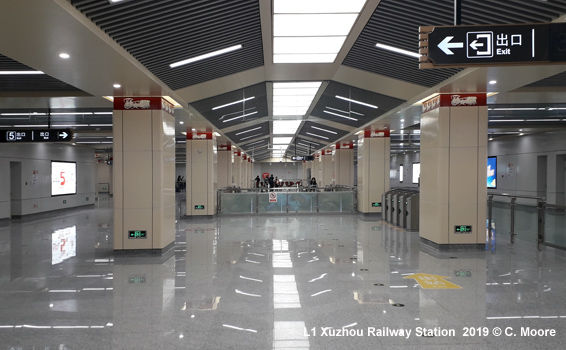
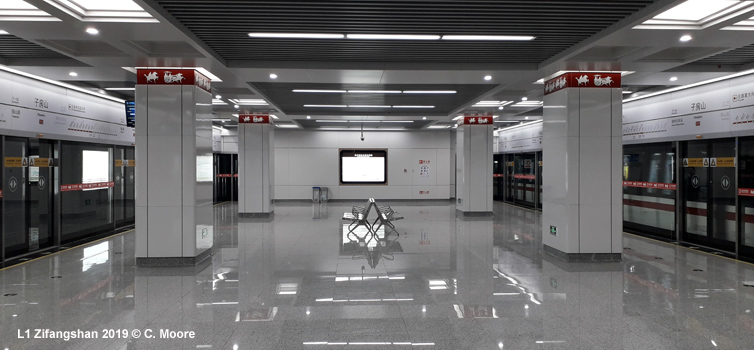
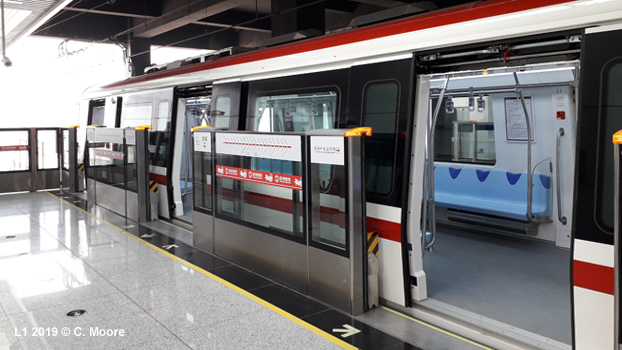
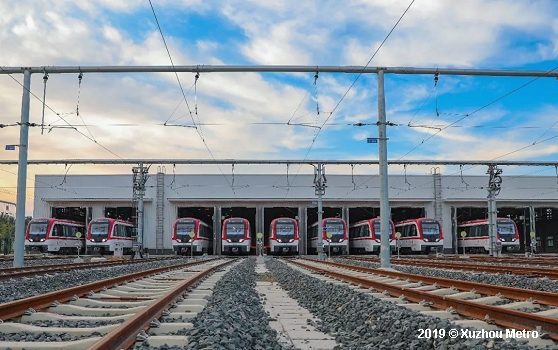
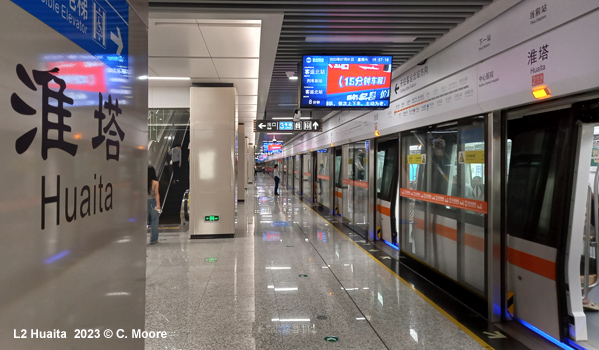
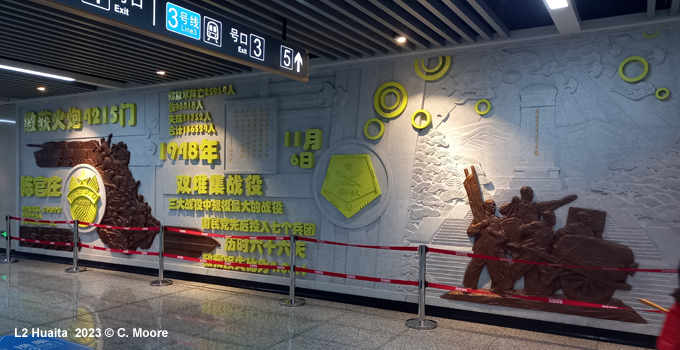
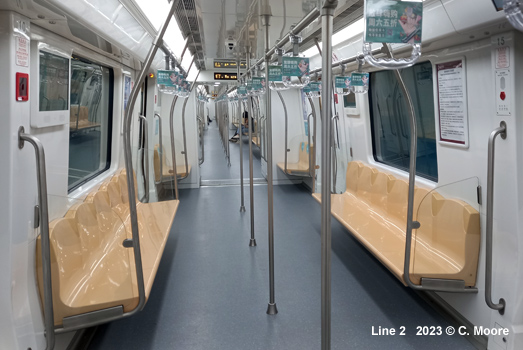
|
| Report |
|
In Oct 2019, Craig Moore reports from Xuzhou: Xuzhou is the largest city in northern Jiangsu and, because of its location at the meeting point of Jiangsu, Henan, Anhui and Shandong, it has long been a strategically important area. As such, Xuzhou boasts a rich history (it was China’s second most important city during the Han Dynasty of 260BC-220AD), and is today a main centre of economic development and agricultural production. Planning for the Xuzhou Metro began in 2011 and construction started in 2014; the Metro eventually started operations on 28 September 2019 as part of the 70th Anniversary celebrations of the founding of the Peoples Republic. This is the fifth new Metro to open in China in 2019 (after Wenzhou, Jinan, Lanzhou and Changzhou) and it is significant that the system opened on ‘Anniversary Weekend’ as in many ways this Metro marks the twilight of the massive urban transport expansion phase that formed part of the 11th and, particularly, the 12th Five-Year Plan (2011-2015). This Plan implemented policy and resources to support urban rail development and expansion for fruition during the 13th Five-Year Plan period (2016-2020) under the drive for ‘Growth-Density-Efficiency’. In the foreseeable future new openings and expansions will not be at the same pace as in the past, yet we can only marvel at the staggering expansion of Metrodom in China since 2010 with the length of China’s entire Metro offer now (Oct 19) at 5500km (imagine Berlin to Karachi by U-Bahn!). Xuzhou City Rail Transit Co. operates a single-line system, branded as Xuzhou Metro. Line 1 runs on the east-west development axis of the city from Luwo in the west to Xuzhou Dong Railway Station. It is 21.3km (revenue Km) with 18 stations and connects the central area with the prominent districts of Bashan and Chendong, as well as the city’s two main transport hubs of Xuzhou Zhan and the eastern terminus of Xuzhou Dong (CRH). Although mainly underground, the line does have a 0.8km elevated section at Luwo where the sheds are located. Services operate from 0600-2130 and there is a 10min base headway (trains have a 5min dwell time at each terminus). The journey takes 39mins. Street entrances are accompanied by a totem and stairs to the mezzanine level. This area is of standard structure with security, ticket machines, information boards (with ornate brown trim), customer offices and barriers (side barriers for entry/end barriers for exit). At the two rail stations, the mezzanine side walls also have large artworks. The dominant colour scheme here and on platforms is white (glazed tiling) with red trim on pillars and coving. This trim has white reliefs of the terracotta figures for which Xuzhou is famed. The platforms are in island form with central lift/stairs and escalators at platform ends. The end walls have maps and seating and toilets are also available on all platforms. Full platform screens are topped by a red strip map and there is metallic calligraphic name plates on stair walls, and smaller station names on pillars. There are also RTI screens. The pillars are embedded in ceilings and surrounded by downlights and ceiling insets, which looks impressive. Although this layout is prototypical in China, the spec is of high quality and there are some notable stations - in particular Pengchengguangchang with its different design styles at each side of the platform and angular pillars with gold trim; Xuzhou Railway Station with a beige colouring and pitched ceilings/latticed lighting; and Xuzhou Dong for its interesting framed coving. Luwo is also different, being the only elevated station on the line. It has side platforms with half screens and is pretty basic, although it has patterned exterior cladding. Currently, only the southern platform is used and all trains switch before the platform arrival. Xuzhou Metro has remained loyal to Jiangsu Province, purchasing CRRC stock from Nanjing Puzhen. The B2 type trains operate in six-car formations and offer a really quiet and smooth ride. The exterior is white with broad black window band and red strip below the window. The front is predominantly red and black. Inside, there is light blue side seating and audio/electronic information in Mandarin/English. Dynamic strip maps have differing degrees of line detail as you progress (this is now considered standard in China!), but there is no schematic on the train. One particular train is branded as a ‘Time Tunnel’ with each carriage having floors, walls and ceilings covered with images to celebrate individual decades since the founding of the PRC in 1949 (the second car covers two decades - 1960-79). Given it is only a single line, the Metro is quite well patronised and is busy to Sudilo before quietening on its way west to Luwo. Tickets are card based and cost 2-5 RMB and there is currently hard copy information available on how to use the system. Wayfinding and signage is bi-lingual and excellent and, as is the norm in provincial China, staff are very friendly, helpful and full of smiles. Although the line has a couple of interesting stations, in the main, it has standard design and operations – but its spec is of high quality. And so, whilst not an outstanding line it is still an impressive addition to the Metro family. As mentioned earlier, in the past decade the expansion of Metro provision in China has been impressive. Scale is one element, but, as Xuzhou illustrates, this expansion has more recently been combined with quality and design. |
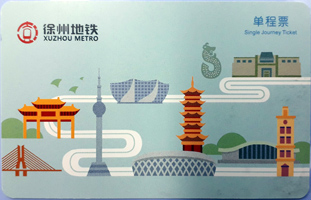
2019 © Robert Schwandl (UrbanRail.Net)